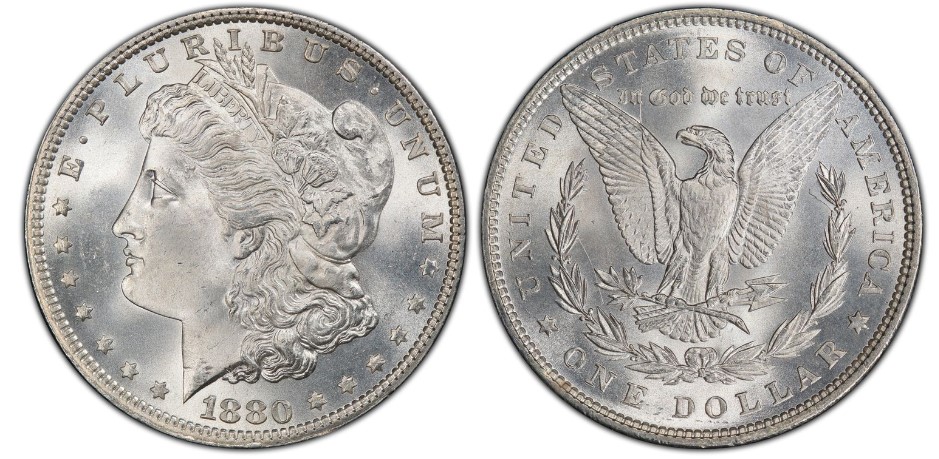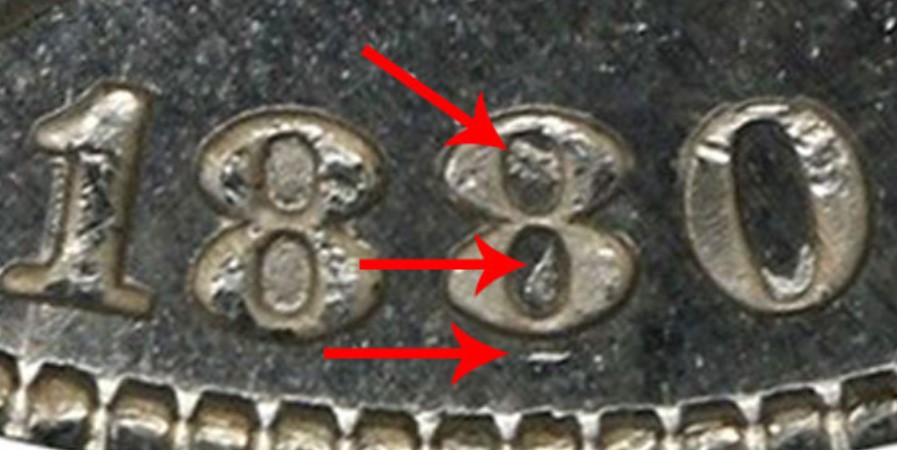1880 Silver Dollar Value: All You Need to Know About the Coin and its Pricing (2022 Update)
Disclosure: We are reader-supported. If you purchase from a link on our site, we may earn a commission. Learn more
Last Updated on: 22nd June 2022, 11:58 pm
After the end of the barter system, the first established forms of currencies took the form of gold, silver, or other precious metals. These were replaced by the modern form of currency notes and coins as governments realized the redundant use of precious metals in currencies.
The early United States established the U.S. Mint in 1792 which, to this day, produces coins as legal tender, including those for investment purposes. These bullion coins accelerate in their value over time due to an increase in the value of the metal they are made of and the fact they are sought after as collectibles and antiques.
1880 Morgan Silver Dollar:
One such bullion coin is the 1880 one dollar coin which is made of 90% silver and 10% copper. According to PCGS (Professional Coin Grading Service), the 1880 silver dollar coin is one of the most popular coins and is named after its designer George T. Morgan. These coins were reintroduced, after a short span of demonetization, through the Bland-Allison Act in 1878.
The 1880 Morgan silver dollar was minted continuously from 1878 to 1904. There was a brief pause before minting resumed in 1921, which later turned out to be the final year of this coin’s issuance.
There are about over 27 million such 1880 silver dollar value coins. These coins were produced at four different mints including Philadelphia (1880), New Orleans (1880-O), San Francisco (1880-S), and Carson City (1880-CC). The highest number of these coins were minted in Philadelphia, with 12.6 million coins.
The 1880 silver dollar coin produced at the Philadelphia mint has a diameter of 38.10 millimeters and a weight of 26.73 grams.

Source: PCGS (Professional Coin Grading Service)
Silver Dollar Coin Characteristics: Things to Keep in Mind
A unique feature that you should keep in mind for the 1880 silver dollar coin minted at Carson City is the digit 7 beneath the digit 8. This can be barely seen after a closer look at the second 8 of the year 1880 on the front of the coin. This hallmark distinguishes it from other silver dollars, and can help tell it apart from counterfeits.

Source: USAcoinbook
Which 1880 Morgan Silver Dollar Coin Should I Choose?
Per the PCGS, there are currently 14 types of 1880 Morgan silver coins for which an auction history is available. Within each coin, auction prices are bifurcated with grades. A grade denotes the condition of a coin, with a low grade fetching a low sale amount and vice versa.
See below for the details on historical prices for coins and the grades within them. This will help us understand the highs and lows in the 1880 silver dollar values. Each column is defined beneath the table:
| # | Coin Name | PCGS # | Grade | Max $ | Min $ | % Change | Period in years | |
| A | B | C | D | E | F | G | ||
| 1 | 1880 $1 (Regular Strike) | 7096 | 66+ | 6,600 | 4,920 | 34% | 2 | |
| 2 | 1880 $1 8/7 Overdate (Regular Strike) | 41097 | 65 | 720 | – | – | – | |
| 3 | 1880-CC $1 (Regular Strike) | 7100 | 67 | 16,750 | 14,100 | 19% | 5 | |
| 4 | 1880/79-CC $1 Reverse of 1878 (Regular Strike) | 7108 | 66 | 6,024 | 3,408 | 77% | 2 | |
| 5 | 1880-CC $1 8/7 High 7 (Regular Strike) | 7102 | 67 | 29,375 | 13,200 | 123% | 9 | |
| 6 | 1880-CC $1 8/7 High 7, DMPL (Regular Strike) | 97103 | 65 | 8,050 | 4,406 | 83% | 17 | |
| 7 | 1880-CC $1 8/Low 7 (Regular Strike) | 7104 | 66+ | 9,694 | 3,840 | 152% | 3 | |
| 8 | 1880-CC $1 8/7 Reverse of 1878 (Regular Strike) | 7110 | 67 | 54,625 | 18,000 | 203% | 15 | |
| 9 | 1880-O $1 (Regular Strike) | 7114 | 65 | 24,000 | 9,000 | 167% | 3 | |
| 10 | 1880-O $1 GSA Hoard (Regular Strike) | 596256 | 0 | – | – | – | – | |
| 11 | 1880/79-O $1 (Regular Strike) | 7116 | 64 | 2,640 | 1,087 | 143% | 6 | |
| 12 | 1880-S $1 (Regular Strike) | 7118 | 68+ | 10,500 | 8,519 | 23% | 3 | |
| 13 | 1880/79-S $1 (Regular Strike) | 7120 | 67 | 2,938 | 1,293 | 127% | 15 | |
| 14 | 1880/9-S $1 (Regular Strike) | 7122 | 68 | 17,250 | 8,625 | 100% | 17 | |
| A – Coin Name = Each 1880 Morgan dollar coin is recognized by a different name
B – PCGS # = This number is a unique identification number for each coin name C – Grade = There are several grades from as low as 1 and up to 70. For our analysis, we have taken auction data available for the highest grade. D – Max $ = This is the maximum auction PCGS value in dollars. It does not necessarily have to be the latest price. E – Min $ = This is the minimum auction PCGS value in dollars. It does not necessarily represent the oldest price. F – % Change = This represents the difference in percentage for a coin between its highest ever and lowest ever dollar values. G – Period in years = The period is considered from the first auction year till the year 2022. The period is rounded off to the nearest year for ease of analysis.
|
||||||||
For clarification purposes, let’s take an example from the above table for line # 8 with PCGS #7110 and grade 67. This 1880 one dollar value (face value) coin peaked in auction for $54,625 in July 2013. The last auction in August 2020 fetched a value of $19,200, which marked a considerable decline.
In short, the 1880 silver dollar value, based on historical auction data, ranges in value from $1,087 USD (for the 1880/79-O Regular Strike) all the way up to $54,625 (for the 1880-CC 8/7 Reverse of 1878). Therefore, there is extreme variation in the resale price of these coins, depending on their specific mintage and their unique grade and condition.
Conclusion: Final Word on 1880 Silver Dollar Coin & Alternatives
While the 1880 Morgan silver dollar coin holds considerable value as a collectible, savvy investors would do well to diversify with precious metals bullion. Investing in gold bullion also helps you avoid gold plated coins, which have relatively low resale value and are sometimes involved in scams.
Before you invest in bullion coins, make sure to perform a basic valuation test. Identify the percentage of precious metal utilized in the coin, its specific fineness, and, finally, calculate the metal price based on today’s gold spot price. This will more or less act as the minimum resale price for the item, and knowing this can help you make a risk-conscious investment decision.
Caution: Please exercise your judgment before deciding to make a purchase. The analysis in this article is intended to clarify some investment details of the 1880 one dollar value coin for analysis purposes only.



 Silver
Silver Gold
Gold Platinum
Platinum Palladium
Palladium Bitcoin
Bitcoin Ethereum
Ethereum

 Gold: $4,087.99
Gold: $4,087.99
 Silver: $50.42
Silver: $50.42
 Platinum: $1,521.77
Platinum: $1,521.77
 Palladium: $1,389.50
Palladium: $1,389.50
 Bitcoin: $85,171.56
Bitcoin: $85,171.56
 Ethereum: $2,797.40
Ethereum: $2,797.40